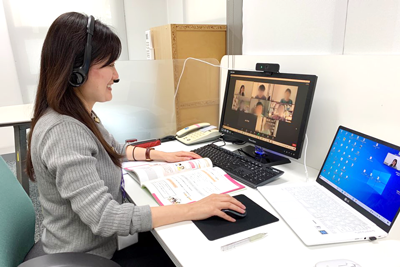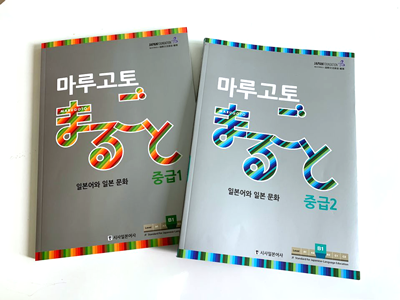2021 Japanese-Language Assistants’ Report: Fun through Expanding and Connecting with the Japanese Language
The Japan Foundation, Seoul
KANEYUKI Megumi
Korea has the third largest number of Japanese language learners in the world, with approximately 530,000 (1), and Japanese language education is thriving in this country. Japanese has been studied in a variety of places and for a variety of purposes, for example, as a second foreign language in junior and senior high schools, to study or work in Japan, as a hobby, or for family connections. When living in Korea, it is not uncommon to meet people who have studied Japanese before. I was posted to Korea in January 2020, and I would like to talk about some of the activities with learners and teachers that I have encountered through the Japanese language over the past year.
Students Connected by their Passion for the Japanese Language
One of the main duties of a Japanese-Language Assistant (hereafter referred to as "Assistant") is to assist in the operation of Japanese language courses offered by the Japan Foundation, Seoul (hereafter referred to as "JF Seoul") for general adult learners, and to teach the classes. Until the 2019 academic year, classes were held in classrooms at JF Seoul, but from the 2020 academic year, due to COVID-19, classes are being held online.
In the 2020 academic year, the Assistant was in charge of three classes using "Marugoto: Japanese Language and Culture" (hereafter referred to as “Marugoto”). I approached my first class at JF Seoul, and my first ever online class, with both anticipation and nervousness. I still remember the first day of class and the slightly nervous but motivated faces of the students who were waiting for the class to start. Even though I was online, I could see on my screen that the students were eager to study Japanese and were passionate about learning the language.
I feel that many of the students are looking forward to meeting and interacting with their peers not only for the sake of learning Japanese, but also through the shared interest in the Japanese language. Therefore, even though we could not meet face-to-face in the online class, we were conscious of trying to make the students feel connected to each other as much as possible.

Online Japanese-language courses
In order for the students to feel connected to each other, we tried to spend a lot of time in each class for the students to share their own experiences and thoughts on the topic, and to get to know each other. The classes are made up of diverse groups of students with different ages, professions, and interests, so there is always something new to discover. For example, on the topic of "Manga," a student who did not have a good impression of Manga became interested in them after listening to a student who loves Manga. In the topic of "festivals," one of the students who said that there were not many festivals in Korea, after hearing about other students' experiences, researched Korean festivals on her own and rediscovered Korea's festival culture. At the end of the roughly three-month course, one student commented, "I was unsure about the online class at first, but I was able to get to know everyone in the class and stick with it until the end." I believe that the students were able to feel that they could connect and learn from each other even online.
Teachers Connected by their Passion for Children Learning Japanese
JF Seoul holds its "Winter Intensive Training Program for Secondary School Japanese Language Teachers" every year for junior high and high school teachers. In the 2020 academic year, the course was held online, and teaching assistants also helped in the administration and gave lectures. It was my first time to be involved in teacher training, so before the training started, I was nervous about what kind of teachers would be taking part. However, as soon as the training started, I saw how eager the teachers were to learn, and I felt that I wanted to think and learn together with them during those five precious days.
During this training, the teaching assistant was responsible for two lectures. There was a class using "Marugoto" to experience a "task-oriented class" and a class on "Dialect (Kansai dialect)", a class activity idea for junior high and high school students. In these two classes, the teachers were asked to experience the class from the standpoint of learners and students. The purpose of the training was to have the participants experience the key words of the training, "task-oriented" classes and "learning without separating culture and language," and to have them come to understand various things about class design and the role of teachers.

Korean version of "Marugoto" Intermediate 1 and 2
During the training, participants work with Japanese-Language Specialists (hereafter referred to as "Specialists") and local teachers in order to connect each lecture toward the training goal. I considered various things as I prepared and conducted my classes, such as how I could pass the baton to the next person, and how I could express myself in a way that would trigger the participants' awareness. Thanks to the guidance and support of the Specialists and local teachers, we were able to get responses from the participants after the training such as "I was able to understand the flow of task-oriented class" and "This will be helpful for my future classes."
This training program gave me the opportunity to experience the passion of the teachers for the children learning Japanese, and to see how they learn and change each other even in a short period of time, which gave me a renewed sense of the appeal of the job of a Japanese language teacher.
Learning and Teaching Japanese
During this year's activities, I have often experienced the joy of learning and teaching Japanese. By learning a foreign language, you will be exposed to new ideas and values that are different from what you have been used to, broadening your horizons and expanding your world. There is also the fun of connecting with new worlds and people through language. I would like to become a Japanese language teacher who can convey the fun of learning a foreign language. I hope to learn more in the remaining year of my term, and to give back to the people who come to learn Japanese.
Note (1): The Japan Foundation Survey Report on Japanese-Language Education Abroad 2018
- What We Do Top
- Arts and Cultural Exchange [Culture]
- Japanese-Language Education Overseas [Language]
- Japanese-Language Education Overseas [Language] Top
- Learn Japanese-language
- Teach Japanese-language
- Take Japanese-Language Test
- Know about Japanese-language education abroad
- The Japanese-Language Institute, Urawa
- The Japanese-Language Institute, Kansai
- Japanese-Language Programs for Foreign Specified Skilled Worker Candidates
- Japanese Language Education for Japanese Children Resident Overseas and for the Descendants of Migrants
- Archives
- Japanese Studies and Global Partnerships [Dialogue]
- JF digital collection
- Other Programs / Programs to Commemorate Exchange Year
- Awards and Prizes
- Publications
